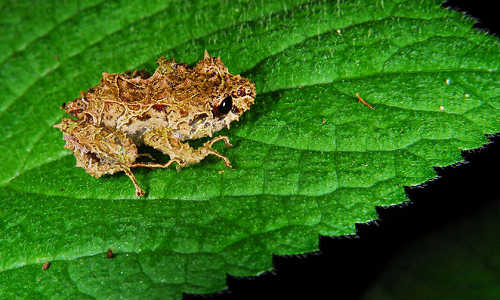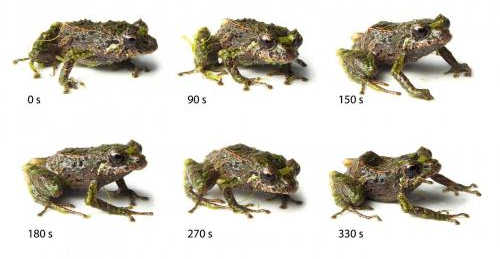A frog in Ecuador’s western Andean cloud forest changes skin texture in minutes, appearing to mimic the texture it sits on.
Skin texture variation in one individual frog (Pristimantis mutabilis) from Reserva Las Gralarias. Note how skin texture shifts from highly tubercular to almost smooth; also note the relative size of the tubercles on the eyelid, lower lip, dorsum and limbs. Credit: Zoological Journal of the Linnean Society
Originally discovered by a Case Western Reserve University PhD student and her husband, a projects manager at Cleveland Metroparks’ Natural Resources Division, the amphibian is believed to be the first known to have this shape-shifting capability.
But the new species, called Pristimantis mutabilis, or mutable rainfrog, has company. Colleagues working with the couple recently found that a known relative of the frog shares the same texture-changing quality—but it was never reported before.
The frogs are found at Reserva Las Gralarias, a nature reserve originally created to protect endangered birds in the Parish of Mindo, in north-central Ecuador.
The researchers, Katherine and Tim Krynak, and colleagues from Universidad Indoamérica and Tropical Herping (Ecuador) co-authored a manuscript describing the new animal and skin texture plasticity in the Zoological Journal of the Linnean Society this week. They believe their findings have broad implications for how species are and have been identified. The process may now require photographs and longer observations in the field to ensure the one species is not mistakenly perceived as two because at least two species of rain frogs can change their appearance.
Katherine Krynak believes the ability to change skin texture to reflect its surroundings may enable P. mutabilis to help camouflage itself from birds and other predators.
The Krynaks originally spotted the small, spiny frog, nearly the width of a marble, sitting on a moss-covered leaf about a yard off the ground on a misty July night in 2009. The Krynaks had never seen this animal before, though Tim had surveyed animals on annual trips to Las Gralarias since 2001, and Katherine since 2005.
They captured the little frog and tucked it into a cup with a lid before resuming their nightly search for wildlife. They nicknamed it “punk rocker” because of the thorn-like spines covering its body.
The next day, Katherine Krynak pulled the frog from the cup and set it on a smooth white sheet of plastic for Tim to photograph. It wasn’t “punk “—it was smooth-skinned. They assumed that, much to her dismay, she must have picked up the wrong frog.
“I then put the frog back in the cup and added some moss,” she said. “The spines came back… we simply couldn’t believe our eyes, our frog changed skin texture!
“I put the frog back on the smooth white background. Its skin became smooth.”
“The spines and coloration help them blend into mossy habitats, making it hard for us to see them,” she said. “But whether the texture really helps them elude predators still needs to be tested.”
During the next three years, a team of fellow biologists studied the frogs. They found the animals shift skin texture in a little more than three minutes.
Juan M. Guayasamin, from Universidad Tecnológica Indoamérica, Ecuador, the manuscript’s first author, performed morphological and genetic analyses showing that P. mutabilis was a unique and undescribed species. Carl R. Hutter, from the University of Kansas, studied the frog’s calls, finding three songs the species uses, which differentiate them from relatives. The fifth author of the paper, Jamie Culebras, assisted with fieldwork and was able to locate a second population of the species. Culebras is a member of Tropical Herping, an organization committed to discovering, and studying reptiles and amphibians.
Guayasamin and Hutter discovered that Prismantis sobetes, a relative with similar markings but about twice the size of P. mutabilis, has the same trait when they placed a spiny specimen on a sheet and watched its skin turn smooth. P. sobetes is the only relative that has been tested so far.
Because the appearance of animals has long been one of the keys to identifying them as a certain species, the researchers believe their find challenges the system, particularly for species identified by one or just a few preserved specimens. With those, there was and is no way to know if the appearance is changeable.
The Krynaks, who helped form Las Gralarias Foundation to support the conservation efforts of the reserve, plan to return to continue surveying for mutable rain frogs and to work with fellow researchers to further document their behaviors, lifecycle and texture shifting, and estimate their population, all in effort to improve our knowledge and subsequent ability to conserve this paradigm shifting species.
Further, they hope to discern whether more relatives have the ability to shift skin texture and if that trait comes from a common ancestor. If P. mutabilis and P. sobetes are the only species within this branch of Pristimantis frogs to have this capability, they hope to learn whether they retained it from an ancestor while relatives did not, or whether the trait evolved independently in each species.
Story Source:
The above story is based on materials provided by University of Case Western Reserve University.






